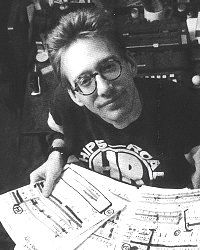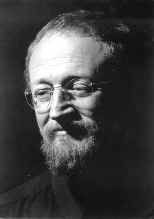Jan — A few days ago Elizabeth Hinkle-Turner pointed
out that women seemed to represent about 50 percent of the downtown electronic music
composers. I wondered why there seem to be more women in that scene (if there are). I
speculated that it might be because the downtowners have possibly rejected the concept of the artist-prophet — a sort of patriarchal,
transcendentally inspired artist who is either seen as a voice of the people, or a voice beyond the
people.
Last night I went to a concert of John Zorn’s music at
the Miller Theater at Columbia University. It is a fairly large hall and it was full. I would guess
that 500 people or so were in attendance, and most seemed to be fans. Before the concert there
was an hour-long interview with the composer conducted by George
Steel.
 Zorn (left) repeatedly stressed that his music comes from some sort of higher power.
Zorn (left) repeatedly stressed that his music comes from some sort of higher power.
He said that it would not have been possible for him to complete over 300 of his Masadic
melodies during a very short time period without some sort of supernatural help. In the program,
he writes that composition is at its best “when the piece is seemingly writing itself and the
composer is merely an observer. He says that some of his works, “transcend my expectations and
my abilities. I cannot explain them. They are part of the Mystery.”
Well, so much for my speculation about downtowners not seeing themselves as
artist-prophets. And I might add that the NYC public seems to view Zorn as a sort of voice of the
people — jazz, rock, pop, cartoons and all. John Cage was an artist-prophet who declared an end
to artist-prophets, but it seems that at least some downtowners, like Zorn, weren’t listening that
closely.
 The music at the concert was not very affecting for me (Bill Oborne,
The music at the concert was not very affecting for me (Bill Oborne,
right), but it was technically brilliant and stunningly performed by a group of about 20 well-known
performers with whom Zorn has long worked. I had not heard his music before and was very
surprised. I have lived abroad for 25 years and could only read about his music in journals or on
the Web. I was expecting a sort of scontchy downtown free improv, but the works presented
were extended, highly chromatic, rhythmically complex, precisely notated and formally structured
works that sounded almost completely uptown — except that it was much better uptown music
than what I heard when I lived in NYC in the late ’70s.
It is interesting that a “downtown” composer like Zorn, who never completed college, has
ended up writing very virtuosic, complex and widely recognized uptown-sounding music, while so
many hundreds of talented and extremely ambitious composers who went through advanced
degrees at Columbia, Princeton, Juilliard, etc. have all vanished into relative oblivion.
Well-informed critics like Kyle Gann still speak of a
downtown and uptown music; but based on most of the concerts I have heard in NYC of late, the
two aesthetic encampments are no longer all that distinct from one another. There seems to be
just one broad, rather eclectic concept of music-making in the city.
Anyway, I am still wondering if it would turn out that fewer women composers than men are
likely to claim they are transcendentally inspired. As women reach equality [see Where Are the Women? — JH], will a matriarchy evolve that
follows the general patterns of patriarchy? Who knows? A good example of a matriarchal
composer might be Pauline Oliveros.
Hastily written thoughts for nothing…
— Bill
Postscript: Kyle Gann, whose self-deprecation is one of his many charms as a
critic, writes: “As you can imagine, Bill’s note sent me into reflexive paroxysms of
self-justification.” Here’s Kyle: Exaggerated Rumors of Downtown’s
Cooptation.




